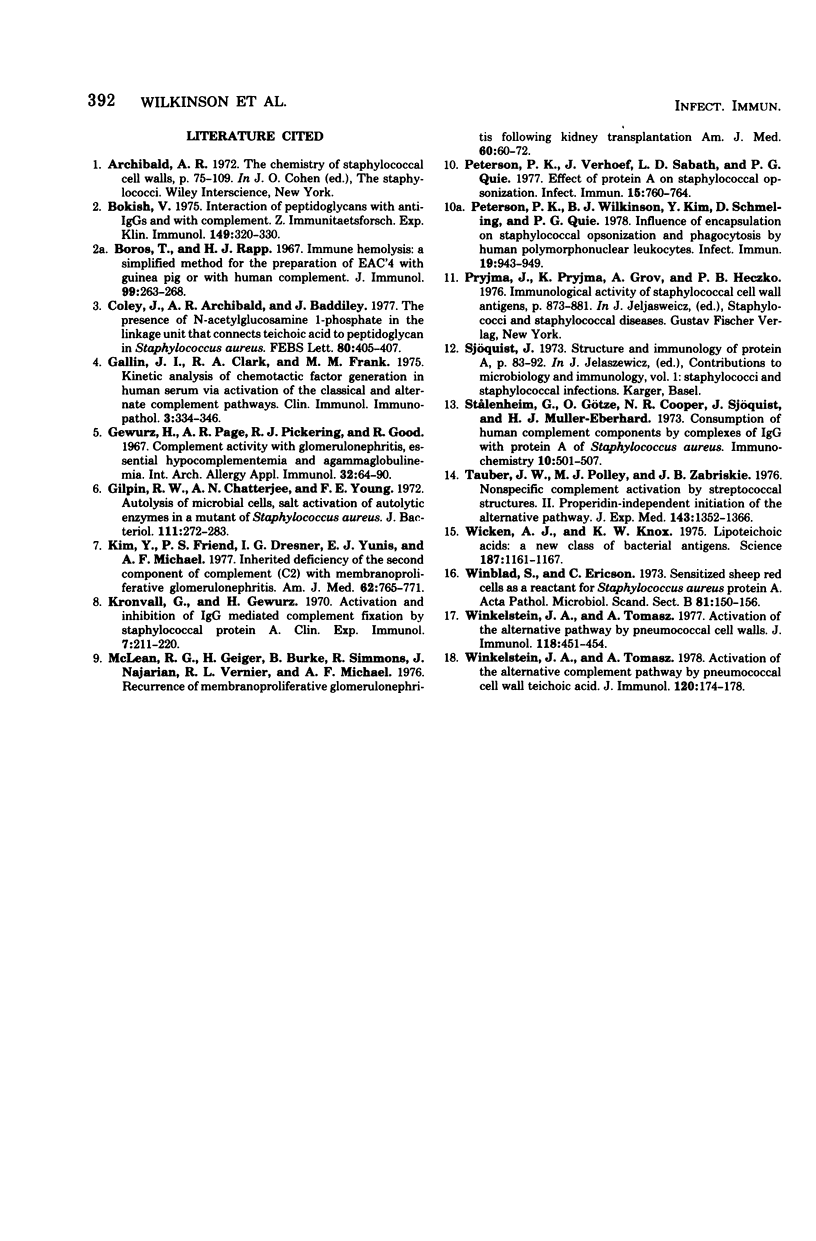Abstract
The abilities of intact Staphylococcus aureus H, crude cell walls (CCW), purified cell walls (PCW, peptidoglycan [PG] and covalently linked teichoic acid), peptidoglycan, and cell membranes (CM) to activate the complement system in normal human serum, C2-deficient serum, and immunoglobulin-deficient serum were compared. On a weight basis, PCW was the most active fraction; intact organisms and CCW were about equally effective; and PG was least active in causing complement consumption in normal serum. CM also activated complement but did not give a clear dose-response relationship in the concentrations used. Kinetic studies revealed that C3-C9 consumption occurred at a significantly slower rate in C2-deficient serum, indicating that intact organisms, PCW, and PG may activate the complement system via the classical and alternative pathways in normal serum. C3-C9 consumption was also slower in immunoglobulin-deficient serum than in normal serum, implying that immunoglobulins play a role in attaining maximum rates of complement activation. In all sera studied, PG was less active in complement activation than PCW. These results indicate that a number of cell surface components of S. aureus can play a role in complement activation by this organism and that the presence of teichoic acid has a significant enhancing effect in this regard.
Full text
PDF




Selected References
These references are in PubMed. This may not be the complete list of references from this article.
- Borsos T., Rapp H. J. Immune hemolysis: a simplified method for the preparation of EAC'4 with guinea pig or with human complement. J Immunol. 1967 Aug;99(2):263–268. [PubMed] [Google Scholar]
- Coley J., Archibald R., Baddiley J. The presence of N-acetylglucosamine 1-phosphate in the linkage unit that connects teichoic acid to peptidoglycan in Staphylococcus aureus. FEBS Lett. 1977 Aug 15;80(2):405–407. doi: 10.1016/0014-5793(77)80486-9. [DOI] [PubMed] [Google Scholar]
- Gallin J. I., Clark R. A., Frank M. M. Kinetic analysis of chemotactic factor generation in human serum via activation of the classical and alternate complement pathways. Clin Immunol Immunopathol. 1975 Jan;3(3):334–346. doi: 10.1016/0090-1229(75)90020-3. [DOI] [PubMed] [Google Scholar]
- Gewurz H., Page A. R., Pickering R. J., Good R. A. Complement activity and inflammatory neutrophil exudation in man. Studies in patients with glomerulonephritis, essential hypocomplementemia and agammaglobulinemia. Int Arch Allergy Appl Immunol. 1967;32(1):64–90. doi: 10.1159/000229917. [DOI] [PubMed] [Google Scholar]
- Gilpin R. W., Chatterjee A. N., Young F. E. Autolysis of microbial cells: salt activation of autolytic enzymes in a mutant of Staphylococcus aureus. J Bacteriol. 1972 Jul;111(1):272–283. doi: 10.1128/jb.111.1.272-283.1972. [DOI] [PMC free article] [PubMed] [Google Scholar]
- Kim Y., Friend P. S., Dresner I. G., Yunis E. J., Michael A. F. Inherited deficiency of the second component of complement (C2) with membranoproliferative glomerulonephritis. Am J Med. 1977 May;62(5):765–771. doi: 10.1016/0002-9343(77)90881-6. [DOI] [PubMed] [Google Scholar]
- Kronvall G., Gewurz H. Activation and inhibition of IgG mediated complement fixation by staphylococcal protein A. Clin Exp Immunol. 1970 Aug;7(2):211–220. [PMC free article] [PubMed] [Google Scholar]
- McLean R. H., Geiger H., Burke B., Simmons R., Najarian J., Vernier R. L., Michael A. F. Recurrence of membranoproliferative glomerulonephritis following kidney transplantation. Serum complement component studies. Am J Med. 1976 Jan;60(1):60–72. doi: 10.1016/0002-9343(76)90534-9. [DOI] [PubMed] [Google Scholar]
- Peterson P. K., Verhoef J., Sabath L. D., Quie P. G. Effect of protein A on staphylococcal opsonization. Infect Immun. 1977 Mar;15(3):760–764. doi: 10.1128/iai.15.3.760-764.1977. [DOI] [PMC free article] [PubMed] [Google Scholar]
- Peterson P. K., Wilkinson B. J., Kim Y., Schmeling D., Quie P. G. Influence of encapsulation on staphylococcal opsonization and phagocytosis by human polymorphonuclear leukocytes. Infect Immun. 1978 Mar;19(3):943–949. doi: 10.1128/iai.19.3.943-949.1978. [DOI] [PMC free article] [PubMed] [Google Scholar]
- Sjöquist J. Structure and immunology of protein A. Contrib Microbiol Immunol. 1973;1:83–92. [PubMed] [Google Scholar]
- Stålenheim G., Götze O., Cooper N. R., Sjöquist J., Müller-Eberhard H. J. Consumption of human complement components by complexes of IgG with protein A of Staphylococcus aureus. Immunochemistry. 1973 Aug;10(8):501–507. doi: 10.1016/0019-2791(73)90221-8. [DOI] [PubMed] [Google Scholar]
- Tauber J. W., Polley M. J., Zabriskie J. B. Nonspecific complement activation by streptococcal structures. II. Properdin-independent initiation of the alternate pathway. J Exp Med. 1976 Jun 1;143(6):1352–1366. doi: 10.1084/jem.143.6.1352. [DOI] [PMC free article] [PubMed] [Google Scholar]
- Wicken A. J., Knox K. W. Lipoteichoic acids: a new class of bacterial antigen. Science. 1975 Mar 28;187(4182):1161–1167. doi: 10.1126/science.46620. [DOI] [PubMed] [Google Scholar]
- Winblad S., Ericson C. Sensitized sheep red cells as a reactant for Staphylococcus aureus protein A. Methodology and epidemiology with special reference to weakly reacting methicillin-resistant strains. Acta Pathol Microbiol Scand B Microbiol Immunol. 1973 Feb;81(1):150–156. [PubMed] [Google Scholar]
- Winkelstein J. A., Tomasz A. Activation of the alternative complement pathway by pneumococcal cell wall teichoic acid. J Immunol. 1978 Jan;120(1):174–178. [PubMed] [Google Scholar]
- Winkelstein J. A., Tomasz A. Activation of the alternative pathway by pneumococcal cell walls. J Immunol. 1977 Feb;118(2):451–454. [PubMed] [Google Scholar]


